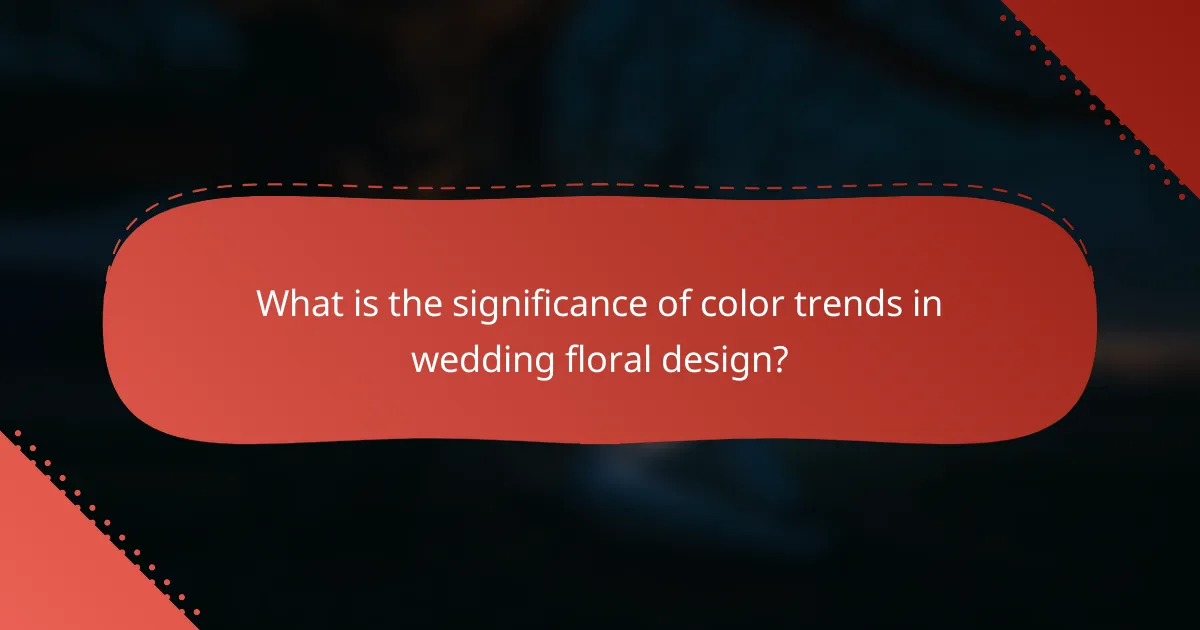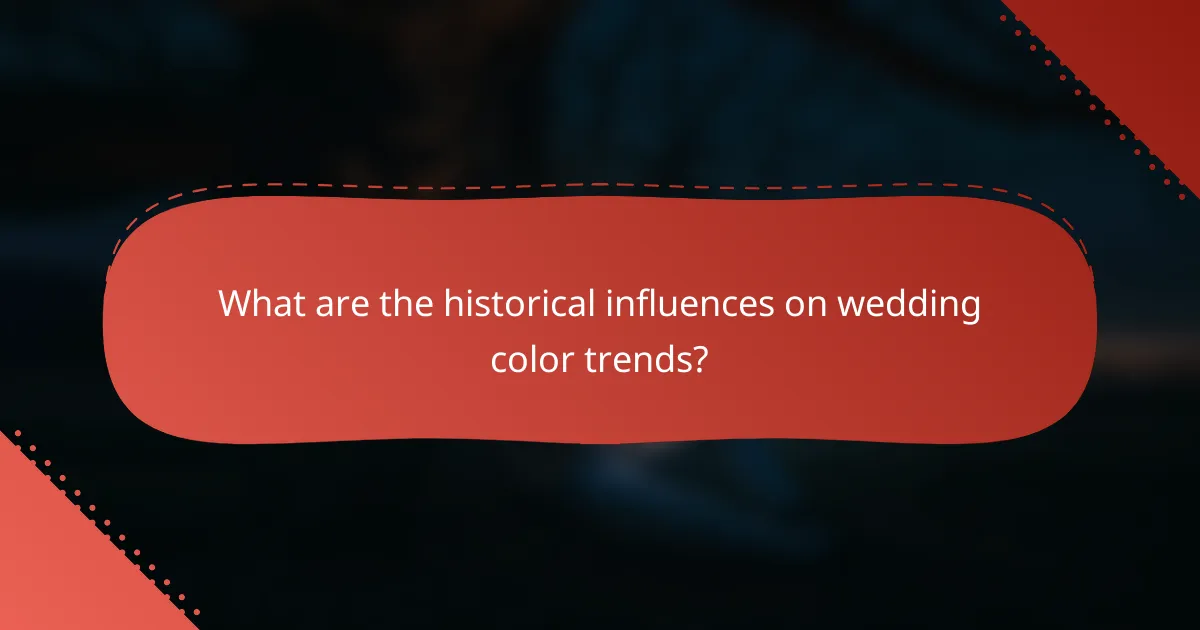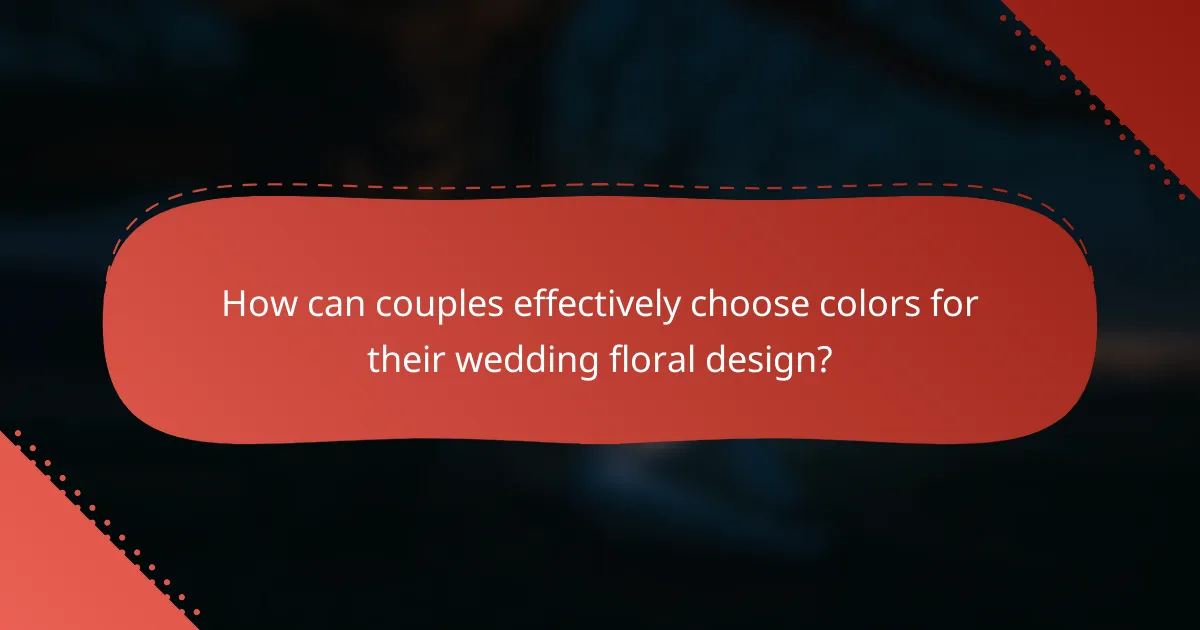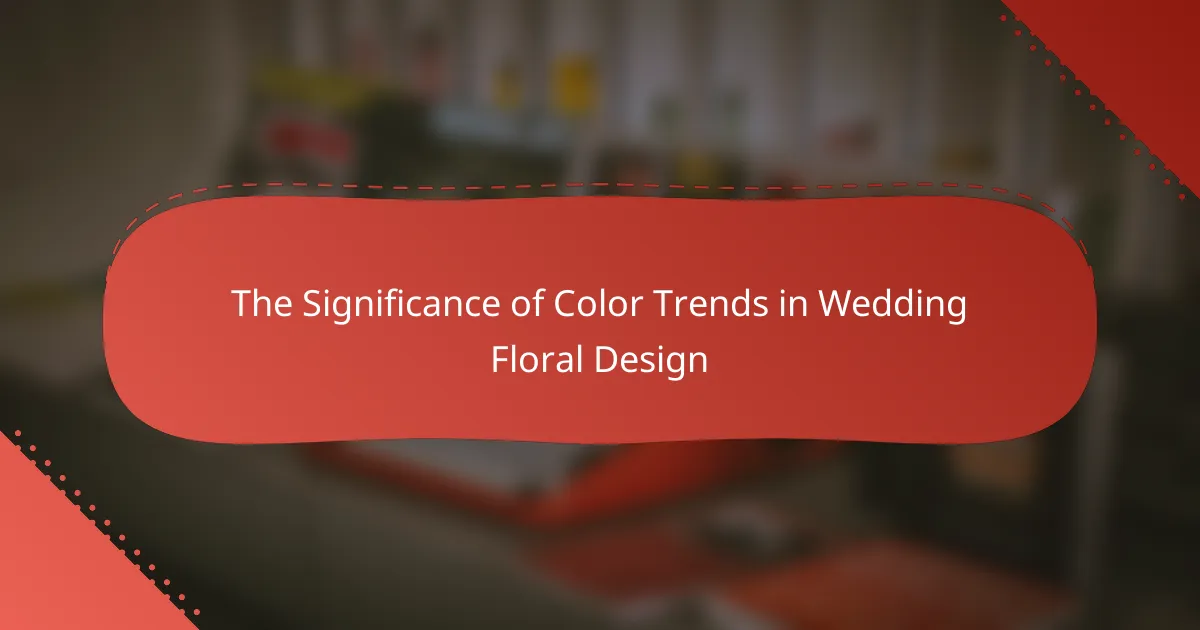
What is the significance of color trends in wedding floral design?
Color trends in wedding floral design are significant as they influence the overall aesthetic and emotional tone of the event. These trends reflect cultural shifts and personal preferences, shaping how couples express their unique identity. For instance, the Pantone Color Institute annually releases a Color of the Year, impacting floral choices across the industry. In 2022, the Color of the Year was Very Peri, a blend of blue and violet, which many couples incorporated into their floral arrangements. This alignment with current trends helps create a cohesive visual experience. Additionally, color trends can evoke specific feelings; soft pastels may convey romance, while bold hues can express vibrancy and joy. Ultimately, incorporating color trends in floral design enhances the wedding’s thematic coherence and emotional resonance.
How do color trends influence wedding floral arrangements?
Color trends significantly influence wedding floral arrangements by dictating the choice of flowers, color palettes, and overall design aesthetics. Florists often align their selections with popular colors to ensure the arrangements resonate with current styles. For instance, a trend towards pastel colors may lead to the use of soft pinks and blues in bouquets.
Color trends also affect the seasonal availability of certain flowers. Flowers that match trending colors are often sourced more readily, enhancing the visual appeal of arrangements. Additionally, color psychology plays a role; certain colors evoke specific emotions, guiding couples in their selection process.
For example, a study by the Pantone Color Institute indicates that colors like greenery promote tranquility, influencing choices in floral design. Thus, color trends not only shape the visual elements but also the emotional undertones of wedding floral arrangements.
What are the key elements of color theory in floral design?
The key elements of color theory in floral design include hue, saturation, and value. Hue refers to the color itself, such as red or blue. Saturation describes the intensity or purity of a color. High saturation means a vibrant color, while low saturation results in a more muted tone. Value indicates the lightness or darkness of a color. A color can be lightened by adding white or darkened by adding black. Understanding these elements helps designers create harmonious arrangements. Color combinations, such as complementary or analogous schemes, also play a crucial role. These combinations influence mood and aesthetic appeal in floral designs.
How do seasonal color palettes affect flower selection?
Seasonal color palettes significantly influence flower selection in wedding floral design. Each season features distinct color trends that guide florists in choosing blooms. For example, spring often highlights pastels like blush pink and soft lavender. Summer typically embraces vibrant hues such as bright yellow and coral. Autumn is characterized by rich, warm tones like deep red and burnt orange. Winter often favors cool colors, including icy blue and silver.
These seasonal palettes help create cohesive aesthetics that align with the overall wedding theme. They also reflect the natural colors found in the environment during each season. Florists often consult seasonal color trends to ensure the floral arrangements complement the wedding decor. This practice enhances the visual appeal and emotional resonance of the event.
Why are current color trends important for wedding planning?
Current color trends are important for wedding planning because they influence the overall aesthetic and theme of the event. Color trends help couples choose palettes that resonate with contemporary styles. They ensure that the wedding decor feels modern and relevant. Incorporating trending colors can enhance the visual appeal of photographs. This alignment with trends can also reflect the couple’s personality and preferences. For instance, the Pantone Color Institute regularly releases color forecasts that shape design choices across industries, including weddings. By following these trends, couples can create memorable experiences that guests will appreciate.
What impact do color trends have on the overall wedding theme?
Color trends significantly influence the overall wedding theme. They set the mood and tone for the event. Specific colors can evoke emotions and create a cohesive aesthetic. For example, soft pastels often convey romance, while bold hues can reflect vibrancy and energy. Color trends also guide floral arrangements, décor, and attire choices. A well-chosen color palette enhances visual harmony across all elements. Research indicates that color psychology plays a role in guests’ perceptions and experiences. Thus, aligning color trends with the wedding theme is essential for a unified celebration.
How can color trends enhance the emotional atmosphere of a wedding?
Color trends can significantly enhance the emotional atmosphere of a wedding. They influence the mood and feelings of the attendees. For instance, warm colors like red and orange evoke passion and energy. In contrast, cool colors such as blue and green promote calmness and tranquility.
The choice of colors can also reflect the couple’s personality and style. This personalization creates a deeper emotional connection for guests. Studies show that color psychology plays a vital role in human emotions. For example, a 2016 study by the Institute for Color Research found that people make a judgment about an environment within 90 seconds, primarily based on color.
Thus, selecting the right color trends can transform the emotional landscape of a wedding, making it memorable for everyone involved.

What are the historical influences on wedding color trends?
Wedding color trends have been influenced by cultural, social, and historical factors. In ancient Rome, brides wore white to symbolize purity, a trend that has persisted. The Victorian era popularized white wedding dresses, further solidifying the color’s association with weddings. The 20th century saw the introduction of pastel colors, reflecting post-war optimism. Additionally, cultural traditions, such as red for luck in Chinese weddings, have shaped color choices. Economic factors also play a role; for instance, during the Great Depression, simpler color palettes emerged. Current trends are influenced by social media and celebrity weddings, which rapidly spread new color ideas. Each historical influence has contributed to the evolving landscape of wedding color trends.
How have wedding color trends evolved over the decades?
Wedding color trends have evolved significantly over the decades. In the 1950s, pastel colors dominated, reflecting a post-war sense of optimism. The 1960s introduced bold and vibrant colors, influenced by the counterculture movement. In the 1970s, earth tones became popular, aligning with the natural and bohemian aesthetic. The 1980s saw a return to bright colors, often paired with metallics, showcasing extravagance. The 1990s shifted towards muted tones and monochromatic palettes, emphasizing sophistication. In the 2000s, soft and romantic hues, like blush and champagne, gained popularity. Recently, the trend has moved towards rich jewel tones and unexpected color combinations, reflecting individuality and personal style. Each decade’s color choices mirror cultural shifts and societal influences, showcasing the dynamic nature of wedding aesthetics.
What cultural factors have shaped color preferences in wedding floral design?
Cultural factors significantly influence color preferences in wedding floral design. Different cultures associate specific colors with meanings and traditions. For example, in Western cultures, white symbolizes purity and new beginnings. In contrast, red is favored in many Asian cultures, representing love and prosperity. Seasonal events also play a role; spring weddings often feature pastel colors, while fall weddings embrace rich, warm tones. Additionally, cultural rituals and customs dictate floral choices and color schemes. For instance, in Hindu weddings, vibrant colors are prominent, reflecting joy and celebration. These cultural associations guide couples in selecting floral arrangements that resonate with their heritage and values.
How do historical events influence contemporary color trends?
Historical events shape contemporary color trends through cultural shifts and societal influences. For instance, the aftermath of World War II saw a rise in pastel colors, reflecting a desire for peace and optimism. The 1960s introduced bold and vibrant colors linked to counterculture movements. Economic factors also play a role; recessions often lead to muted color palettes in design. In contrast, periods of prosperity might favor more vibrant hues. Additionally, significant events, like the rise of environmental awareness, have led to an increase in earthy tones. Color forecasting agencies track these influences, providing insights into future trends. Thus, the interplay between history and color choices is evident in contemporary design.
What role do influencers and media play in shaping color trends?
Influencers and media significantly shape color trends through their extensive reach and visibility. Influencers showcase particular colors in their content, making them desirable to their followers. Social media platforms like Instagram and Pinterest amplify these trends, allowing colors to gain popularity quickly. Media outlets often highlight color palettes in seasonal reports, influencing designers and consumers alike. Research indicates that 70% of consumers are influenced by social media when making purchasing decisions related to aesthetics. This dynamic creates a feedback loop where popular colors are featured more, reinforcing their status. Overall, influencers and media play a crucial role in establishing and popularizing color trends in various industries, including wedding floral design.
How do social media platforms impact floral design choices?
Social media platforms significantly influence floral design choices by showcasing trends and styles. Visual platforms like Instagram and Pinterest allow florists to share their work widely. This exposure leads to increased awareness of popular floral arrangements and color palettes. Users often seek inspiration from trending posts, which impacts their selection for weddings and events. According to a survey by WeddingWire, 75% of couples find floral inspiration on social media. This trend encourages florists to adapt their designs to align with what is popular online. As a result, floral design choices are increasingly driven by social media trends.
What are the most significant trends set by wedding influencers?
Wedding influencers are shaping significant trends in the wedding industry. They promote unique floral color palettes that reflect personal styles. Influencers are emphasizing sustainable and locally sourced flowers. They also advocate for personalized floral arrangements that tell a story. Social media platforms showcase these trends, influencing brides’ choices. According to a survey by The Knot, 80% of brides are inspired by social media for their floral designs. Influencers are also highlighting the use of bold colors and unconventional flower types. This trend leads to more vibrant and customized wedding aesthetics.

How can couples effectively choose colors for their wedding floral design?
Couples can effectively choose colors for their wedding floral design by considering their wedding theme and personal preferences. They should start by selecting a color palette that reflects their style. Popular color combinations can inspire their choices. Couples can also consider the season of their wedding, as certain colors resonate more during specific times of the year. For example, pastels are often favored in spring, while rich jewel tones are ideal for fall.
Additionally, they should think about the venue’s color scheme and decor. This ensures that the floral arrangements complement the overall aesthetic. Couples can use color wheel tools to visualize combinations and contrasts. Consulting with a florist can provide expert guidance on flower availability and seasonal options. Researching current color trends can also help couples stay updated and inspired. These strategies lead to a cohesive and visually appealing floral design.
What are some tips for selecting a wedding color palette?
To select a wedding color palette, start by considering the season of your wedding. Each season has colors that naturally fit; for example, pastels are popular in spring. Next, think about the venue’s colors and decor. The palette should complement the setting to create a harmonious look. Additionally, choose colors that reflect your personal style and the mood you want to convey. Research color theory to understand how colors work together. Use tools like color swatches or online color palette generators for inspiration. Lastly, involve your partner in the selection process to ensure both preferences are considered.
How can personal style influence color choices?
Personal style significantly influences color choices by reflecting individual preferences and aesthetics. A person’s style can dictate their affinity for certain colors, whether bold and vibrant or soft and muted. For instance, someone with a minimalist style may prefer neutral tones, while a bohemian style might embrace rich, earthy colors. This connection between style and color choice shapes the overall visual impact of designs. Research indicates that color psychology plays a role in emotional responses, further linking personal style to color preferences. Therefore, understanding one’s style can lead to more intentional and meaningful color selections in various contexts, including wedding floral design.
What practical considerations should couples keep in mind when choosing colors?
Couples should consider the emotional impact of colors when choosing their wedding palette. Different colors evoke specific feelings; for example, blue can create calmness while red may symbolize passion. They should also think about the season and venue. Seasonal colors can enhance the overall aesthetic. The venue’s existing colors can influence how well new colors will blend. Lighting is another factor; natural light can alter color perception. Couples should also consider their personal preferences and cultural significance of colors. Lastly, they should ensure colors complement each other to create a cohesive look.
What are the common mistakes to avoid in wedding color selection?
Common mistakes to avoid in wedding color selection include choosing colors that clash. This can create a disjointed visual experience. Another mistake is ignoring the season’s natural palette. Seasonal colors enhance the overall theme and ambiance. Additionally, failing to consider the venue’s color scheme can lead to mismatched aesthetics. It’s crucial to ensure that the colors complement the space. Overcomplicating the color palette is also a frequent error. Sticking to a few main colors creates cohesion. Lastly, neglecting the couple’s personal style can result in a wedding that feels impersonal. Personal preferences should guide color choices for authenticity.
How can couples ensure their chosen colors complement the venue?
Couples can ensure their chosen colors complement the venue by considering the venue’s existing color palette. They should analyze the walls, furniture, and decor to identify dominant and accent colors. Selecting colors that either match or harmonize with these elements creates a cohesive look. Using color swatches can help visualize how their choices will interact with the venue’s features. Additionally, couples can consult color theory to understand complementary and analogous color combinations. Research shows that cohesive color schemes enhance the overall aesthetic, making the event more visually appealing. Couples may also seek professional advice from wedding planners or florists to ensure their color choices align with the venue’s style.
What should couples consider regarding flower availability and color?
Couples should consider seasonal availability when choosing flowers for their wedding. Different flowers bloom at specific times of the year. For example, peonies are typically available in late spring. Color preferences also play a crucial role in floral selection. Certain colors may be more readily available in specific seasons. For instance, vibrant hues may be abundant in summer, while pastel shades are popular in spring. Couples should also factor in local flower availability. Sourcing flowers from local growers can enhance freshness and reduce costs. Understanding these elements helps couples make informed decisions for their wedding floral design.
What are the best practices for incorporating color trends in wedding floral design?
Incorporating color trends in wedding floral design involves selecting a cohesive palette that aligns with current trends. Start by researching seasonal colors through design resources like Pantone. Choose flowers that naturally fit these colors, ensuring they complement the overall wedding theme. Use accent colors to add depth and interest to arrangements. Balance bold colors with softer hues to create visual harmony. Consider the venue’s color scheme, as it influences the floral design’s effectiveness. Incorporating greenery can enhance color vibrancy and provide a fresh look. Lastly, consult with a professional florist for expert guidance on achieving the desired aesthetic.
The main entity of the article is color trends in wedding floral design. The article examines the significance of these trends, highlighting their influence on the aesthetic and emotional tone of weddings. Key topics include how color trends shape floral arrangements, the elements of color theory, the impact of seasonal palettes, and the historical and cultural factors that inform contemporary color choices. Additionally, the article discusses the role of social media and influencers in shaping these trends, as well as practical tips for couples in selecting colors that enhance their wedding theme and emotional atmosphere.
